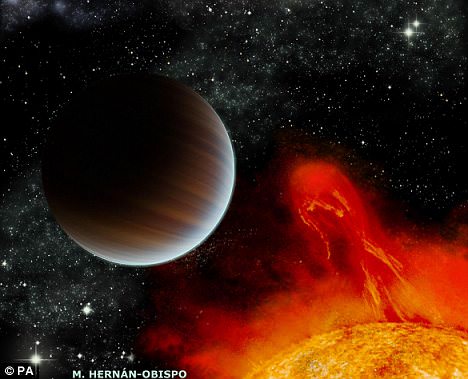[/caption]
Overcoming interference from a very active young sun-like star, a group of astronomers were able to find what they determined is the youngest exoplanet yet discovered. BD+20 1790b is 35 million years old (Earth is about 100 times older at 4.5 billion years) and is located about 83 light years away from our planet. Previously, the youngest known exoplanet was about 100 million years old. Studying this planet will help our understanding of planetary evolution.
While this new-found planet is young, it is a whopper, at six times the mass of Jupiter. It orbits a young active star at a distance closer than Mercury orbits the Sun.
Most planet-search surveys tend to target much older stars, with ages in excess of a billion years. Young stars usually have intense magnetic fields that generate solar flares and sunspots, which can mimic the presence of a planetary companion and so can make extremely difficult to disentangle the signals of planets and activity.
BD+201790 is a very active star, and astronomers announced last year that it could possibly have a companion. An international collaboration of astronomers, led by Dr. Maria Cruz Gálvez-Ortiz and Dr. John Barnes were able to “weed out” the data to determine the planet was actually there.
“The planet was detected by searching for very small variations in the velocity of the host star, caused by the gravitational tug of the planet as it orbits – the so-called “Doppler wobble technique,” said Gálvez-Ortiz. “Overcoming the interference caused by the activity was a major challenge for the team, but with enough data from an array of large telescopes the planet’s signature was revealed.”
The team has been observing the star for the last five years at different telescopes, including the Observatorio de Calar Alto (Almería, Spain) and the Observatorio del Roque de los Muchachos (La Palma, Spain).
Source: Alpha Galileo


How do they know the age of the planet? Is it from estimating the age of the star?
@Jens:
Exactly my question. In addition, how can they know with any degree of certainty that this is an exoplanet, and not a binary star system?
Seems to me with it being interpreted as a gas giant 6 times the size of Jupiter and so close to its host star, it may be another star. From the information presented in the article, I don’t see exoplanet as the sole conclusion.
This news is from December of 2009.
Relevant paper:
http://arxiv.org/abs/0912.2773
It can’t be a binary system. A star must have about 100 times the mass of Jupiter to initiate nuclear fusion.
As for the age, the star was identified as a main sequence star in a certain phase of its existence.
LC
@ Lawrence B. Crowell
Depends on what you define as a binary system. If a binary system is just any two-body system, then this one fits the bill.
What William was getting at is how well do we know that the companion to BD+20° 1790 (not simply BD+201790 as stated here) is truly a planet? instead of a brown dwarf?
There seems to be no dividing line, but rather, an overlap between that which is a brown dwarf and that which is a planet. We see planetary mass brown dwarfs (as BD+20° 1790 b may well be), and brown-dwarf mass planets (XO-3 b?).
One might offer the formation method as the discriminate. If we accept that planets form by core accretion, and stars and brown dwarfs form by gravitational instability of a disk, then it’s okay. (though there may be a smaller(?) overlap between even these two)..
Gravitational instability can crank out planetary mass objects in the timescales of a few centuries, as opposed to several Myr as required for core accretion. GI requires a massive disk though. If BD+20° 1790 b formed through GI, then it may have been able to migrate to its currently location quickly enough (due to the enhanced disk mass) to be observed in its current state.
Core accretion of BD+20° 1790 and subsequent migration would take a while. Perhaps longer than the system age.
Although there is some debate on what is the lower limit mass of a brown dwarf… without knowing the composition or any visual reference, and going by mass and size alone… most scientists lean towards a mass around 20 times that of Jupiter, although you will also have a minority go down as far as 10 times Jupiter’s mass.
Density is a big player at the lower levels/classes. If the object in question is just a bit larger than Jupiter, but has 20 times the mass, then brown dwarf will be favored over being a planet.
In this case, I’m not sure we can find anyone who will support a brown dwarf at only 6 times Jupiter’s mass.
@ Aodhhan
Due to gravitational compression of planets, they are not expected to get much larger than a few tens of a percent more than Jupiter is. This has yet to be tested for gas giant planets in non-close orbits where tidal heating and stellar irradiation (and perhaps other mechanisms) puff them up to observed radii.
The generally agreed-upon brown dwarf cut-off limit is at ~13 Jupiter-masses as this is when deuterium fusion is suspected to begin.
And as a matter of fact, six Jupiters is within the realm of possibility for gravitational instability. See this post from oklo.org
http://oklo.org/2009/06/01/vb-10b/
“I wouldn’t call VB 10b a planet in the usual sense. With a mass of order one-tenth that of its parent star, it’s almost certainly straggling in at the very bottom of the stellar initial mass function. It’s a low-mass brown dwarf impinging into the “planet desert” from above. ”
(VB 10 b was dis-proven later, but the point still stands about planets of around 6 Jupiters)